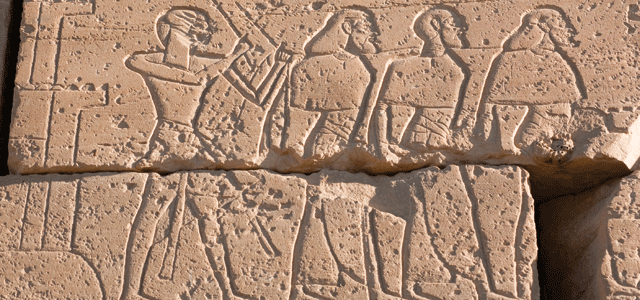
There is much to see in Turkey. There are the seven churches of Asia, the strange chimneys and underground cities of Cappadocia, Mount Ararat in the east, and the throbbing life of Istanbul in the west. But what fascinates me most are the haunts of the ancient Hittites.
There is the Hittite Hotel, the Hittite Taxi Company, the Hittite Restaurant and the Hittite Souvenir Shop. But it has not always been like that. Until 1880, scholars didn’t think the Hittites had ever existed.
But the Bible mentions the name nearly 50 times, and those who believed the Bible to be an accurate account of ancient events continued to accept as fact their existence, in spite of a lack of historical and archaeological support. The critics of the Bible scoffed, saying that there were no such people. That is, until Archibald Henry Sayce announced to an incredulous group of scholars in London that certain strange artifacts turning up all over Turkey originated with the biblical Hittites.
Kaymakli Underground City is the
most extensive underground city of the Cappadocia region.
These troglodyte cave-cities were carved out
underneath a rock hill (Kaymakli Castle).
The first three floors were probably carved out
by the Hittites at about 2000 B.C.
Who were they?
Since the Hittite language and hieroglyphs are now understood, we can know much of their history. Their language had a number of Indo-European features, leading some scholars to conclude that they originally migrated from Europe about 1600 b.c. Others claimed that the Hittites were already there and the Indo-Europeans simply invaded their country and imposed their language on them.
Anitta is credited with being the first great king of the Hittites and he conquered and destroyed a city called Hattusa, placing a curse on anyone who rebuilt it. The curse was ineffectual, however, because his successor, Hattusili, rebuilt it and made it his capital city. His teenage son, Mursili, succeeded him. Mursili marched an army south, crossed the Euphrates River and conquered Aleppo.
Mursili expanded the Hittite power further. He not only destroyed Aleppo but marched his troops down the Euphrates valley to Babylon, which he looted, thus bringing the dynasty of Hammurabi to an end. Telipinu was the last king of the Hittite Old Kingdom.
There was remarkable gender equality among the Hittites. The woman who held the administrative post of the Tawananna wielded a lot of authority in the land. No-one knows quite what this position was, although some believe it was a title for the queen of the Hittites. Regardless, it was a position always held by a woman.
Egyptian threat
Further to the south, the powerful eighteenth dynasty of Egypt posed a threat to the borders of the Hittite kingdom. Thutmose I of Egypt marched as far north as the Euphrates, challenging Hittite authority in the area. Chariots were by then a major weapon of war, but the Hittites went one better, using cavalry, the first nation to do so. In the Istanbul Museum is a cuneiform tablet upon which is written a horse training manual—how to break in a new horse for riding.
Suppiluliuma I (1344–1322 b.c.) was the greatest of the Hittite kings, a natural diplomat. He sent a message of congratulations to Pharaoh Akhenaten on his accession to the Egyptian throne and also negotiated a marriage with Malnigal, the daughter of the king of Babylon.
In Egypt, Akhenaten was followed by Tutankhamun, who ruled only nine years. After his death, Suppiluliuma was astonished to receive a letter from Tutankhamun’s widow saying, “I have no son, but they say you have many sons. If you would give me one of your sons, he would become my husband. I will never take a servant of mine and make him my husband.”
Suppiluliuma was suspicious and sent a delegation to Egypt to see if the letter was genuine. It was, and Suppiluliuma immediately sent his son with a delegation to Egypt. But the delay proved fatal—his son died before he reached Egypt, but his father accused the Egyptians of murdering him.
Ramses II (1303–1213 b.c.) met the Hittites in the battle of Kadesh and was lucky to escape with his life. Kadesh is significant as the first recorded battle in history. But the two superpowers wisely decided to return to diplomacy rather than prolong a futile war. A formal written agreement was exchanged between the two parties and the agreement was sealed by a marriage between Ramses and a Hittite princess, who became his great chief wife.
The end of a people
The Hittites were reputedly a friendly people. While gate posts to Egyptian and Assyrian cities were engraved with kings exterminating their enemies, the Hittites displayed a sense of humour on theirs. A gate at Alaca Hoyuk contains a relief of three acrobats, one a sword swallower, another a fire-eater and the third climbing a ladder not attached to a wall. The message seems to be, “Come on in, enjoy yourself.” The people themselves appear as more cartoonish than realistic.
On the assumption that the so-called Sea Peoples depicted on the walls of the Medinet Habu temple of Ramses III were responsible for the ultimate defeat of the Hittites, their end is usually placed about 1200 b.c., but Assyrian reliefs left by Shalmaneser III in the ninth century B.C., and Sennacherib in the eighth century B.C. indicate that they met their end at the hands of Assyrian armies some five centuries later.
The Bible certainly indicates that they were still at the height of their power in the ninth century B.C. The Syrians were besieging Samaria when they suddenly fled, “for the Lord had caused the Arameans to hear the sound of chariots and horses and a great army, so that they said to one another, ‘Look, the king of Israel has hired the Hittite and Egyptian kings to attack us!’ ” (2 Kings 7:6).
The Istanbul and Ankara museums are stacked high with impressive statues and reliefs from the time of the Hittite empire, most dated to the era of Assyrian domination.
A visit to Hattusa, now known as Bogazkale, is an exciting experience. There is the King’s Gate, the Sphinx Gate, strong walls stretching for over four kilometres, dozens of temples that have been excavated and a list of kings engraved on the face of the rock by Suppiluliuma.
The Hittites were a great empire, but before 1880, the only source of information about them was found in the Bible, which had it been believed, may well have advanced our archaelogical knowledge of them much earlier. Belief in the Bible has many advantages, all of which, it appears, are eventually proven.









